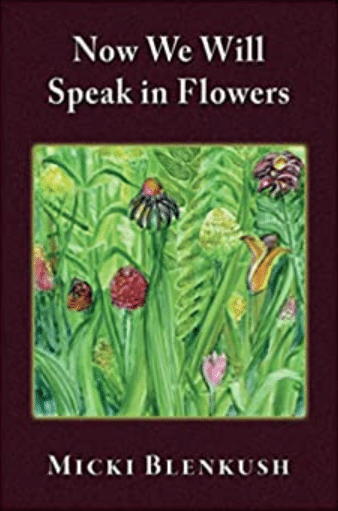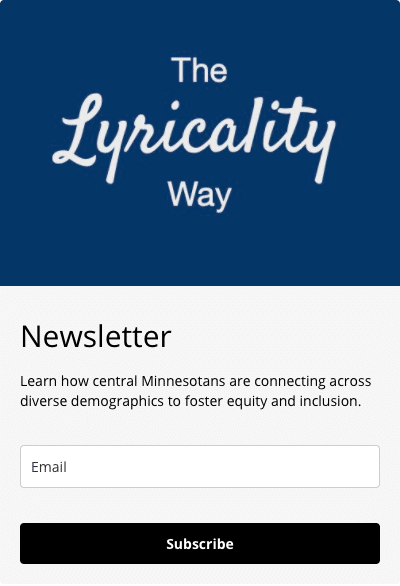In this article, I will share a short review of central Minnesota writer Micki Blenkush’s first collection of poems, Now We Will Speak in Flowers, and then show you how you can read this book as a way to cultivate empathy.
You don’t have to know anything about poetry to use this method for cultivating the art of empathy by reading poems. All you need is a willingness to be curious, which is the first step toward developing a stronger sense of empathy.
Now We Will Speak In Flowers by Micki Blenkush: a mini-review
Micki Blenkush’s first collection, Now We Will Speak in Flowers, takes me to the heart’s burial ground, that place where I’ve covered over all that has been lost, discarded, or taken from the familial relationships that ought to, but don’t, assuage my deep, human need for connection. And as in real cemeteries, everything I’ve buried is surrounded by silence.
This collection grapples with the tensions between actual and idealized versions of reality. What keeps me from running away from these tensions are the persistent sparks of hope I encounter. In these poems I discover that even when life doesn’t fit our idealized versions of it, even when we experience the pain of disconnection, there is love.
This poet does not candy-coat or sentimentalize the nature of human experience. Instead, she boldly explores human vulnerability in themes of connection/disconnection, and how extreme disconnection may lead to extremely altered states of perception. And it is exactly this sense of actuality that fosters the art of empathy.
Reading this book gives me the feeling that the narrator and the characters created by the poet, the “people” I encounter in this book, are real. This poet (who is also a professional social worker) is showing us how people in real life actually think, feel, and behave. This works to challenge our assumptions about what people “ought to” think, feel, and do, and that challenge works to develop our empathy.
The entire collection works as a witness. But this is not the witness of accusation but instead, an enlightening testimony of what was and what is. The speaker of these poems, in a singular, compassionate voice, strives for the space and the process to achieve the goal of being a true witness. That makes the achievement of this collection valuable. These poems are an accurate, representation of the narrator’s experience, rendered with astonishing clarity, precision, and insightful grace.
How to read Now We Will Speak in Flowers by Micki Blenkush as a way to cultivate empathy
In a recent article about what empathy is, some general ways people cultivate it, and why literary writing fosters the art of empathy, I shared 5 practices of highly empathetic people which we will bring to our reading of Now We Will Speak in Flowers: curiosity; deep listening; vulnerability; seeing through the different eyes; and challenging our preconceptions and prejudices.
1) Read with curiosity
Harvard Business Review tells us that developing our curiosity has the benefit of making us into creative problem solvers in the face of tough situations. Curiosity helps us survive a constantly changing environment, makes us happier, and boosts achievement, as well as expanding our empathy, which strengthens our relationships.
Poetry is not news. It is also not a diary of someone’s self-expression. Poetry is art made of heightened language. We don’t poetry read it to “get” it. We read to experience it, to be touched by it, trusting that the artist-poet knows what she is doing in creating an interactive experience for us, her readers. So be curious. Ask questions. What’s going on here?
The first page after the table of contents is mostly white space, with a 6-word quote by Theodore Roethke. You might ask who that is, so here’s a link to more information about Theodore Roethke than you probably want to know. It’s probably enough to know that he’s an early twentieth-century American poet who wrote the words, “May my silences become more accurate.”
Why did the poet open her book with those words? Good question. Carry it with you as you continue to read. Turn the page; notice the title again. Now We Will Speak in Flowers. How can people speak in Flowers? Is Flowers a language like Korean or Somali? Add those to your question kit and carry them along on your journey through this book.
See yourself as an explorer. You’re walking through strange terrain, trying to acquaint yourself with the landscape, its elements, and microclimates. Turn the page.
You find one poem clustered into five groups three short lines; Painted Cave. Scan the poem with your eyes. Look at the last word of each line. This is a technique practiced readers of poetry use to look for patterns—the way you’d scan a convention hall or a landscape to get a sense of what’s happening before going in.
Notice the title, Painted Cave, and the words—crawling, memory, shapes, calligraphy, light, move, lived, maps, know, pattern, then, skin, sketches, beasts, know. How interesting — we’re looking for patterns and then we see the word pattern.
All that I think I know
can be traced to pattern.
Why did she say “All that I think I know” instead of “All that I know”? Why is there a space between those lines—a blank or silence in the middle of the sentence? What does this poem have to do with silences? What are accurate silences?
Add those questions, too, to your question kit as you move on, because that’s what curious people do. They want to see what’s beyond the next turn in the road, over the next hill so they keep going.
Turn the page.
Notice the section Title: Milky Blood Evidence. Pick it up and add this to your collection of specimens.
Keep turning the pages to explore this book. After you’ve given yourself an overview, revisit some of the poems and read to listen deeply.
2) Read to Listen Deeply
A good poem (or poetry collection) is like a good relationship—we’re not in a hurry to finish it because it makes us feel more alive. And there’s also more to discover.
To listen deeply to a poem is to allow it to be incomplete. We understand that we can’t ever know everything about a person. We have to give people time to reveal their histories and inner workings, and our relationship will change over time. The sense of incompleteness keeps us curious about people, which keeps us interested in the relationship.
Poetry is a relationship. To discover its depth and enjoy its nuances, we have to get involved with a poem. To coax poems to give more of themselves to us, we must have faith in them, we must give them our attention, and we must listen deeply to them.
This practice is based on an ancient method of sacred reading, a way of relating to words that transform us into people who know how to listen with the ear of the heart.
Reading as a practice in Deep Listening
- Read: In silence, be attentive to the poem. Don’t worry about puzzling through what it means, just let it wash over you like music. Simply create a space of hospitality for the rhythm, feelings, and sounds and colors you experience. If you wish, jot down any impressions that arise. Close your eyes and rest for a moment.
- Meditate: Read the words again, and this time pay attention to some part that pulls at you or seems to glimmer at the edges. It could be a shimmering image, a line, even a single word or color, a single element of an image. Be attentive. Let what ever you are noticing resonate in you. Sit in the shimmering space and be open.
- Listen: Read/view again, this time out loud asking what the words or the image is saying to you through the poem/art. Do you hear a question? An invitation?
- Offer: Give your response—gratitude, hope, fear, pain, awe—in a word or phrase, an image, a sign/gesture, or a metaphor. Examples of images include: a color, a drawing or doodle, or a picture of an object in your imagination or memory. Examples of gestures include: bowing; opening fists to let go; swaying or rocking as if to comfort a child in your arms. Examples of a metaphor include: like a child on summer vacation, I fall fearlessly backwards off a dock ; or, I am a still pool at night, reflecting pinpoints of starlight.
- Contemplate: You are invited to surrender in a moment of silence, trusting in the goodness capable of transforming you and the world. Abide in the presence of your inner wisdom now, resting in the oceanic joyful/sorrowful, light/dark, ordinary/sacred, mysterious experience of being human.
3) Read to embrace vulnerability
Try reading as a practice in deep listening with the poem“Passing Through the Thicket” on p 82. Imagine yourself as vulnerable as the poem’s narrator, having to “sidle between / half-naked water aerobic ladies at the gym. Then imagine yourself as vulnerable as one of the ladies the narrator talks about. Contemplate how poetry helps us embrace our vulnerability.
4) Read to see through the different eyes
Try reading as a practice in deep listening with “A Cargo of Perspective” on p 48. It’s a gem of a poem, inspired by the classic children’s books, The Borrowers View the world through the eyes of a child who owns nothing.
5) Read to challenge your preconceptions and prejudices
Try this practice with “Love Letter to the Crowd” on p 102, and challenge your assumptions about who is and isn’t on your side, and who you cannot and can find affection for.
The Pleasure of Poetry and the Art of Empathy
Try reading poetry as a practice in the development of empathy. You might discover, as we at Lyricality have found, that poetry brings beauty, joy, and delight to the cultivation of empathy. And that’s why we call it The Art of Empathy.
If you liked this article and want more good news about how central Minnesota organizations and artists are practicing the art of empathy, sign up to receive our quarterly newsletter The Lyricality Way: The Art of Empathy.
Acknowledgements:
Reading as a Practice in Deep Listening by Tracy Rittmueller is made up of ideas cultivated from: the Benedictine practice of Lectio Divina, Carrie Meyer’s blog, Ravished by Light; and Richard Rohr’s Meditations: Franciscan Way: Part Two: Weekly Summary—October 12, 2019

